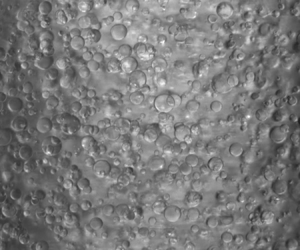Crossref Citations
This article has been cited by the following publications. This list is generated based on data provided by
Crossref.
Vela-Martín, Alberto
and
Avila, Marc
2021.
Deformation of drops by outer eddies in turbulence.
Journal of Fluid Mechanics,
Vol. 929,
Issue. ,
Liu, Hao-Ran
Chong, Kai Leong
Ng, Chong Shen
Verzicco, Roberto
and
Lohse, Detlef
2022.
Enhancing heat transport in multiphase Rayleigh–Bénard turbulence by changing the plate–liquid contact angles.
Journal of Fluid Mechanics,
Vol. 933,
Issue. ,
Wang, Cheng
Yi, Lei
Jiang, Linfeng
and
Sun, Chao
2022.
How do the finite-size particles modify the drag in Taylor–Couette turbulent flow.
Journal of Fluid Mechanics,
Vol. 937,
Issue. ,
Pandey, Vikash
Mitra, Dhrubaditya
and
Perlekar, Prasad
2022.
Turbulence modulation in buoyancy-driven bubbly flows.
Journal of Fluid Mechanics,
Vol. 932,
Issue. ,
Wang, Cheng
Yi, Lei
Jiang, Linfeng
and
Sun, Chao
2022.
Turbulence drag modulation by dispersed droplets in Taylor–Couette flow: the effects of the dispersed phase viscosity.
Journal of Fluid Mechanics,
Vol. 952,
Issue. ,
Crialesi-Esposito, Marco
Rosti, Marco Edoardo
Chibbaro, Sergio
and
Brandt, Luca
2022.
Modulation of homogeneous and isotropic turbulence in emulsions.
Journal of Fluid Mechanics,
Vol. 940,
Issue. ,
Yi, Lei
Wang, Cheng
van Vuren, Thomas
Lohse, Detlef
Risso, Frédéric
Toschi, Federico
and
Sun, Chao
2022.
Physical mechanisms for droplet size and effective viscosity asymmetries in turbulent emulsions.
Journal of Fluid Mechanics,
Vol. 951,
Issue. ,
Trummler, T.
Begemann, A.
Trautner, E.
and
Klein, M.
2022.
Numerical investigation of the segregation of turbulent emulsions.
Physics of Fluids,
Vol. 34,
Issue. 11,
Yi, Lei
Wang, Cheng
Huisman, Sander G.
and
Sun, Chao
2023.
Recent developments of turbulent emulsions in Taylor–Couette flow.
Philosophical Transactions of the Royal Society A: Mathematical, Physical and Engineering Sciences,
Vol. 381,
Issue. 2243,
Crialesi-Esposito, M.
Boffetta, G.
Brandt, L.
Chibbaro, S.
and
Musacchio, S.
2023.
Intermittency in turbulent emulsions.
Journal of Fluid Mechanics,
Vol. 972,
Issue. ,
Hori, Naoki
Ng, Chong Shen
Lohse, Detlef
and
Verzicco, Roberto
2023.
Interfacial-dominated torque response in liquid–liquid Taylor–Couette flows.
Journal of Fluid Mechanics,
Vol. 956,
Issue. ,
Crialesi-Esposito, Marco
Chibbaro, Sergio
and
Brandt, Luca
2023.
The interaction of droplet dynamics and turbulence cascade.
Communications Physics,
Vol. 6,
Issue. 1,
2023.
Effect of micro-grooves on drag reduction in Taylor–Couette flow.
Physics of Fluids,
Vol. 35,
Issue. 4,
Krzeczek, Oscar
Trummler, Theresa
Trautner, Elias
and
Klein, Markus
2023.
Effect of the Density Ratio on Emulsions and Their Segregation: A Direct Numerical Simulation Study.
Energies,
Vol. 16,
Issue. 7,
p.
3160.
Su, Jinghong
Yi, Lei
Zhao, Bidan
Wang, Cheng
Xu, Fan
Wang, Junwu
and
Sun, Chao
2024.
Numerical study on the mechanism of drag modulation by dispersed drops in two-phase Taylor–Couette turbulence.
Journal of Fluid Mechanics,
Vol. 984,
Issue. ,
Moradi Bilondi, Abbas
Scapin, Nicolò
Brandt, Luca
and
Mirbod, Parisa
2024.
Turbulent convection in emulsions: the Rayleigh–Bénard configuration.
Journal of Fluid Mechanics,
Vol. 999,
Issue. ,
He, Yijian
Hong, Qian
Zhang, Dongsheng
and
Kong, Bo
2024.
Evaluation of Droplets Breakup Models of Emulsification Process in a Liquid–Liquid Taylor–Couette Flow.
Industrial & Engineering Chemistry Research,
Vol. 63,
Issue. 18,
p.
8401.
Su, Jinghong
Wang, Cheng
Zhang, Yi-Bao
Xu, Fan
Wang, Junwu
and
Sun, Chao
2024.
Turbulence modulation in liquid–liquid two-phase Taylor–Couette turbulence.
Journal of Fluid Mechanics,
Vol. 999,
Issue. ,
Ni, Rui
2024.
Deformation and Breakup of Bubbles and Drops in Turbulence.
Annual Review of Fluid Mechanics,
Vol. 56,
Issue. 1,
p.
319.
L’Estimé, Manon
Schindler, Michael
Shahidzadeh, Noushine
and
Bonn, Daniel
2024.
Droplet Size Distribution in Emulsions.
Langmuir,
Vol. 40,
Issue. 1,
p.
275.




